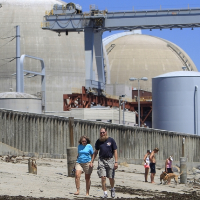Edison Wants to Restart San Onofre Nuclear Plant for 5 Months to See What’s Still Shakin’
 San Onofre Nuclear Generating Station
San Onofre Nuclear Generating Station
Nine months after radioactive steam leaking from vibrating generator tubes damaged by faulty engineering led to a shutdown of the twin nuclear reactors at San Onofre, Southern California Edison would like to fire the plant back up and see if it can operate safely at 70% power.
Environmentalists, anti-nuclear activists and S. David Freeman, former head of the Public Utilities Commission, think that might be premature. “Both these reactors are alike and neither is safe to operate,” according to Freeman, who advises the environmental group Friends of the Earth. “While Edison may be under financial pressure to get one up and running, operating this badly damaged reactor at reduced power without fixing or replacing these leaky generators is like driving a car with worn-out brakes.”
There is no denying the financial pressure and ever-present need for energy. Repair and replacement costs for the plant reached $165 million at mid-year and it remains unclear whether shareholders or ratepayers are going to pick up the tab. Before the plant was shut down, it provided electricity for 1.4 million homes in California.
On Thursday, Edison officials announced that it would like to take a stab at turning one of the two damaged reactors back on at reduced power for five months, to find out if the partial replacement of damaged generators is sufficient. It can’t make a move, however, until the U.S. Nuclear Regulatory Commission (NRC) signs off on their plan. That could take months, and there is no start date on the table.
Nuclear engineer Arnie Gundersen says Edison wants to take a big gamble. “Restarting San Onofre without repairing the underlying problems first turns Southern California into a massive science experiment,” Gundersen, who has produced three independent technical reports commissioned by Friends of the Earth, said. More than 7 million people live within 50 miles of the San Onofre plant, located between San Diego and Los Angeles.
“This is not an experiment,” Edison senior vice president Pete Dietrich insisted at a press conference, where he explained that damage to Unit #2 was not as severe as that which might result in the permanent mothballing of Unit #3.
Both units got remodeled generators in 2009 and 2010 at a cost of $670 million. But poor design apparently led to unanticipated wear from vibration and friction in 15,000 places among 3,401 tubes carrying radioactive steam. More than 50% of tube walls were worn away in 280 spots in Unit #3. A 30% erosion is considered dangerous. Tubes in Unit #2 were eroded in varying measure and not all are being replaced.
A report by Fairewinds Associates used NRC data to determine that San Onofre has had to plug 3.7 times as many bad tubes as all other nuclear plants in the country combined. Fairewinds said operating the reactors with the remaining, worn tubes could create cascading failures, leading to a catastrophic failure that would release significant radiation.
After the Edison announcement, shares of its stock rose 1.5% before settling at $47.10, up 1.07% for the day.
–Ken Broder
To Learn More:
Edison Seeks to Restart San Onofre Unit, Run Below Capacity (by Mark Chediak and Jim Polson, Bloomberg BusinessWeek)
Troubled Calif. Nuke Plant Aims to Restart Reactor (by Michael R. Blood, Associated Press)
Edison Wants to Restart One of San Onofre's Nuclear Reactors (by Abby Sewell, Los Angeles Times)
San Onofre: Restarting of Troubled Nuclear Plant Planned (by Michael R. Blood, Associated Press)
San Onofre Reactor Restart a Reckless Gamble with Southern Californians’ Safety (Friends of the Earth)
Feds Bury Info on Website about San Onofre Troubles (by Ken Broder, AllGov)
- Top Stories
- Controversies
- Where is the Money Going?
- California and the Nation
- Appointments and Resignations
- Unusual News
- Latest News
- California Forbids U.S. Immigration Agents from Pretending to be Police
- California Lawmakers Urged to Strip “Self-Dealing” Tax Board of Its Duties
- Big Oil’s Grip on California
- Santa Cruz Police See Homeland Security Betrayal in Use of Gang Roundup as Cover for Immigration Raid
- Oil Companies Face Deadline to Stop Polluting California Groundwater





